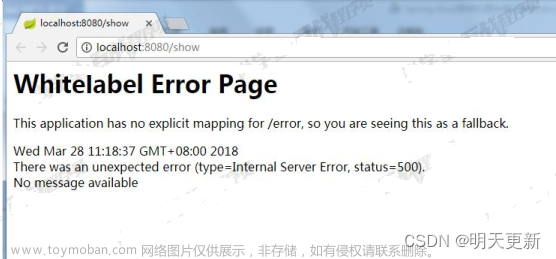- SpringBoot中异常处理的流程图

在SpringBoot项目中,如果业务逻辑发生了异常,则首先看发生异常的类中有没有@ExceptionHandle能处理,如果能,则执行方法进行处理,如果没有,则去找全局的@ControllerAdvice注解,进行异常处理,如果还是不能处理,则继续看SpringMVC的异常处理机制能否处理,这里SpringMVC的异常处理机制就是可以处理默认的十几种异常,如请求类型错误Method Not Allowed,如请求体内容错误等,如果不能处理,则走SpringBoot提供的异常处理机制。SpringBoot的异常处理机制就是将当前异常请求重定向到/error请求,并且会自动根据内容协商是返回页面还是json数据。
所有有时当无法处理异常时,转发到/error请求后又会来带一些其他问题。
- ErrorMvcAutoConfiguration 自动配置类
ErrorMvcAutoConfiguration 这个类是SpringBoot提供用于处理异常机制的。
首先这个类中给容器中注入了一个 Controller文章来源:https://www.toymoban.com/news/detail-564902.html
@Bean
@ConditionalOnMissingBean(value = ErrorController.class, search = SearchStrategy.CURRENT)
public BasicErrorController basicErrorController(ErrorAttributes errorAttributes,
ObjectProvider<ErrorViewResolver> errorViewResolvers) {
return new BasicErrorController(errorAttributes, this.serverProperties.getError(),
errorViewResolvers.orderedStream().collect(Collectors.toList()));
}
@Controller
@RequestMapping("${server.error.path:${error.path:/error}}")
public class BasicErrorController extends AbstractErrorController {
private final ErrorProperties errorProperties;
/**
* Create a new {@link BasicErrorController} instance.
* @param errorAttributes the error attributes
* @param errorProperties configuration properties
*/
public BasicErrorController(ErrorAttributes errorAttributes, ErrorProperties errorProperties) {
this(errorAttributes, errorProperties, Collections.emptyList());
}
/**
* Create a new {@link BasicErrorController} instance.
* @param errorAttributes the error attributes
* @param errorProperties configuration properties
* @param errorViewResolvers error view resolvers
*/
public BasicErrorController(ErrorAttributes errorAttributes, ErrorProperties errorProperties,
List<ErrorViewResolver> errorViewResolvers) {
super(errorAttributes, errorViewResolvers);
Assert.notNull(errorProperties, "ErrorProperties must not be null");
this.errorProperties = errorProperties;
}
@RequestMapping(produces = MediaType.TEXT_HTML_VALUE)
public ModelAndView errorHtml(HttpServletRequest request, HttpServletResponse response) {
HttpStatus status = getStatus(request);
Map<String, Object> model = Collections
.unmodifiableMap(getErrorAttributes(request, getErrorAttributeOptions(request, MediaType.TEXT_HTML)));
response.setStatus(status.value());
ModelAndView modelAndView = resolveErrorView(request, response, status, model);
return (modelAndView != null) ? modelAndView : new ModelAndView("error", model);
}
@RequestMapping
public ResponseEntity<Map<String, Object>> error(HttpServletRequest request) {
HttpStatus status = getStatus(request);
if (status == HttpStatus.NO_CONTENT) {
return new ResponseEntity<>(status);
}
Map<String, Object> body = getErrorAttributes(request, getErrorAttributeOptions(request, MediaType.ALL));
return new ResponseEntity<>(body, status);
}
@ExceptionHandler(HttpMediaTypeNotAcceptableException.class)
public ResponseEntity<String> mediaTypeNotAcceptable(HttpServletRequest request) {
HttpStatus status = getStatus(request);
return ResponseEntity.status(status).build();
}
protected ErrorAttributeOptions getErrorAttributeOptions(HttpServletRequest request, MediaType mediaType) {
ErrorAttributeOptions options = ErrorAttributeOptions.defaults();
if (this.errorProperties.isIncludeException()) {
options = options.including(Include.EXCEPTION);
}
if (isIncludeStackTrace(request, mediaType)) {
options = options.including(Include.STACK_TRACE);
}
if (isIncludeMessage(request, mediaType)) {
options = options.including(Include.MESSAGE);
}
if (isIncludeBindingErrors(request, mediaType)) {
options = options.including(Include.BINDING_ERRORS);
}
return options;
}
/**
* Determine if the stacktrace attribute should be included.
* @param request the source request
* @param produces the media type produced (or {@code MediaType.ALL})
* @return if the stacktrace attribute should be included
*/
protected boolean isIncludeStackTrace(HttpServletRequest request, MediaType produces) {
switch (getErrorProperties().getIncludeStacktrace()) {
case ALWAYS:
return true;
case ON_PARAM:
return getTraceParameter(request);
default:
return false;
}
}
/**
* Determine if the message attribute should be included.
* @param request the source request
* @param produces the media type produced (or {@code MediaType.ALL})
* @return if the message attribute should be included
*/
protected boolean isIncludeMessage(HttpServletRequest request, MediaType produces) {
switch (getErrorProperties().getIncludeMessage()) {
case ALWAYS:
return true;
case ON_PARAM:
return getMessageParameter(request);
default:
return false;
}
}
/**
* Determine if the errors attribute should be included.
* @param request the source request
* @param produces the media type produced (or {@code MediaType.ALL})
* @return if the errors attribute should be included
*/
protected boolean isIncludeBindingErrors(HttpServletRequest request, MediaType produces) {
switch (getErrorProperties().getIncludeBindingErrors()) {
case ALWAYS:
return true;
case ON_PARAM:
return getErrorsParameter(request);
default:
return false;
}
}
/**
* Provide access to the error properties.
* @return the error properties
*/
protected ErrorProperties getErrorProperties() {
return this.errorProperties;
}
}
通过分析这个类的源码得知,此类主要就是给SpringMVC映射了两个请求,来处理 /error请求。
而两个方法分别是返回html页面与json数据的。文章来源地址https://www.toymoban.com/news/detail-564902.html
到了这里,关于SpringBoot 异常处理机制的文章就介绍完了。如果您还想了解更多内容,请在右上角搜索TOY模板网以前的文章或继续浏览下面的相关文章,希望大家以后多多支持TOY模板网!












